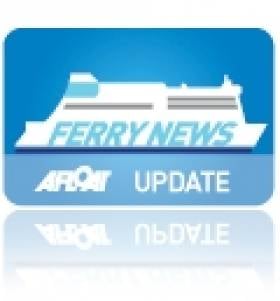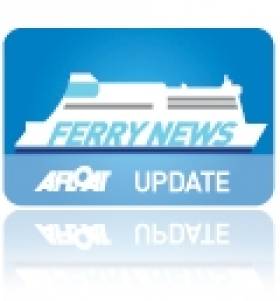Displaying items by tag: BelfastLiverpool (Birkenhead)
Extra Freight Capacity As Stena Set to Introduce '4-Runner' Class to Belfast–Liverpool Service
#FerryNews - Responding to growing market-led demand, Stena Line is planning to upweight its freight capacity on the busy Belfast – Liverpool (Birkenhead) route this month.
The operator will initially deploy the 3,000 lane metre Stena Forerunner, before replacing it with a similar ship early in 2019. At which point the Stena Forerunner will return to service in the North Sea, where Afloat adds a half sister Stena Carrier is currently operating, having called earlier this summer to Dun Laoghaire Harbour.
The planned deployment Afloat adds follows another freightferry Stena Scotia that has already transferred to the Irish Sea but onto the Belfast-Heysham route.
Stena Line’s CEO Niclas Mårtensson said: “Demand for freight capacity from Belfast continues to increase and we believe it is vital that Stena Line provides the necessary capacity and frequency to enable that expansion to flourish. Stena Line will continue to operate seven vessels on its three routes to and from Belfast serving Cairnryan, Heysham and Liverpool and the introduction of the Stena Forerunner will provide us with greater capacity and flexibility to service market demand.
Paul Grant, Stena Line Trade Director commented: “This latest investment by Stena Line yet again highlights our commitment to the freight market. This year we’re experiencing strong growth of 6% on our Belfast – Liverpool route. Future plans for the introduction of two new build ferries on this service during spring 2020 and early 2021, combine to demonstrate a significant long-term commitment to the region by Stena Line. Belfast is now firmly established as the preferred hub for Northern Ireland freight. Stena Line’s unique ability to offer reliability, frequency and choice of routes for the accompanied and unaccompanied segments from a single location is a big advantage for the freight industry.”
When Stena Line initially deploys the 210-trailer unit Stena Forerunner on the Belfast-Liverpool route it will increase weekly freight capacity on the service by almost 10%. They will replace it with a similar ship early in 2019 at which point the Stena Forerunner will return to service in the North Sea (where Afloat adds this ship is at present serving the route to Rotterdam).
Björn Petrusson, Stena Line’s Chief Commercial Officer, North Sea and Irish Sea commented: “Stena Line is actively seeking relief tonnage for the North Sea during this period as we are fully aware that a reduction in the number of ships, though temporary, is not the optimal solution for our customers there.”
Delayed Freight-Ferry's Launch on Belfast-Liverpool Route
#FreightFerry – Stena Line's plan to launch a freight-only ferry on the Belfast-Liverpool (Birkenhead) on Tuesday as previously reported, has been delayed to next week, writes Jehan Ashmore.
Having had technical issues, the 114-trailer capacity Stena Hibernia (1996/13,007grt) also encountered bad weather. She is currently in the English Channel on a repositioning voyage understood to have departed from Brunsbuettel.
The introduction of Stena Hibernia as the routes third ship will see the vessel join passenger ro-pax sisters Stena Lagan and Stena Mersey. The 1996 built freight-ferry will initially run 8 sailings weekly departing Belfast Tues-Fri (at 15.00hrs) and from Birkenhead Tues – Fri (at 0300hrs).
For the ferry aficionado, the use of 'Hibernia' as you may recall is not the first vessel name given to a Stena ship. The last and former Dun Laoghaire-Holyhead conventional car-ferry St. Columba was renamed Stena Hibernia following a major refit in 1991.
Her owners choose to revive one of the traditional 'mail' boat names along with 'Cambria' on the Welsh route as running mate Stena Cambria was relocated from the Dover-Calais route, where she originally served as the St. Anselm.
#FreightFerry – A third vessel, Stena Hibernia (1996/13,007grt) will be adding extra freight capacity to Stena Line's Belfast-Liverpool (Birkenhead) service.
The 114-trailer capacity freight ferry Stena Hibernia will be introduced onto the route from 5 November and will initially operate eight sailings per week. These additional sailings will depart Birkenhead Tues – Fri (at 0300hrs) and will depart Belfast Tues – Fri (at 1500hrs).
As previously reported on Afloat.ie, Stena Line acquired the Belfast-Liverpool and Belfast-Heysham services from DFDS Seaways in July 2011and has since invested in increasing capacity and improving the service.
Paul Grant, Stena Line's Route Manager Irish Sea North said: "The freight market is showing signs of recovery and it's important that Stena Line adds capacity to accommodate the expected growth."
Stena Hibernia had previously served on the Belfast-Heysham route for Stena and also during DFDS operations. She was launched at a Japanese shipyard as Maersk Importer.
Sponsorships of Ice-Sea Giants
Stena Line themselves will be looking forward to introducing their own giants when two of the largest ferries are to be introduced on the North Channel in the Autumn. The two chartered 30,000grt sisterships are Superfast VII and Superfast VIII. To see the vessel breaking through an an ice-flow, click PHOTO. The 203m long pair can take 1,200 passengers, around 660 cars or 110 freight vehicles. To read more about these 'Superfast' class vessels and the new £80 port terminal click HERE.
The company's area director Michael McGrath said: "It's quite fitting that we are teaming up with the Stena Line Belfast Giants at this time as we prepare to introduce two of the largest ferries every to sail between Northern Ireland and Scotland when we open our new route and port in Cairnryan this November. The two Superfast vessels will be another two Giants to add to our team."
Last year Stena Line made a £40m acquisition of the Belfast to Liverpool (Birkenhead) and Heysham routes and four vessels from DFDS Seaways. The deal was approved by the Irish authorities but remained subject to clearance from the UK's Competition Commission until late last month when they fully approved the acquisition.
This brings to six routes the company runs on its Irish Sea route network where over two million passengers were carried each year, more than its rival ferry operators combined.
- DFDS Seaways
- Belfast Harbour
- Stena Line
- North Channel
- Competition Commission
- BelfastHeysham
- Superfast VII
- Superfast VIII
- Belfast Lough News
- Belfast Port
- Odyssey Arena
- Belfast Giants
- BelfastCairnryan
- New ferryport
- Nottingham Panthers
- Sheffield Steelers
- Hockey Festival Weekend
- BelfastLiverpool (Birkenhead)
- Irish Sea ferry companies
- Irish icehockey































































